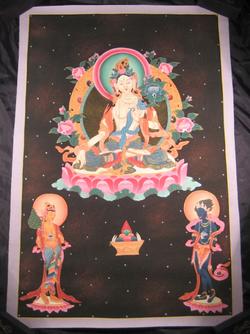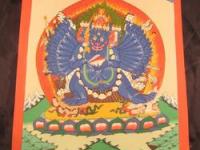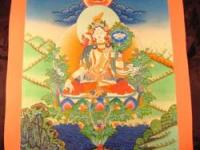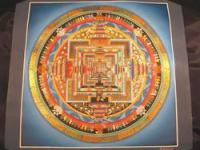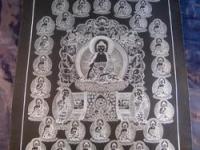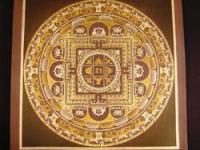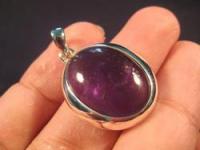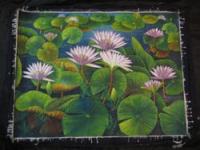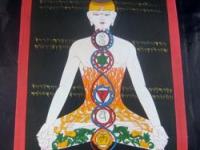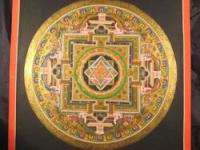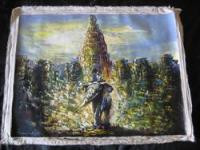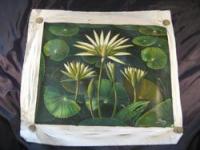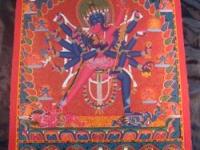This is a Large hand painted original Cosmic White Tara painting from Nepal. I brought it back with me from my last trip there. The colors are lovely and real 24 K gold paint was used as an accent. It is so spiritual how she is floating in space. The Mother of all Buddhas.
Some history of the White Tara:
A late development in Mahayana Buddhism is that the Adi Buddha, Dhyani Buddhas, and Bodhisattvas received female partners. Female Bodhisattvas, who appear starting in the sixth century, are called taras. Tara means “Star,” “Savior,” or “leader.” the various taras can be recognized by the color of their skin, among other things.
In the seventh century, Tibet made its entrance onto the international political stage. King Songtsen Gampo unified Tibet and conquered parts of China and Nepal. He made two important political marriages with princesses from neighboring countries. Both ladies practiced Buddhism, and therefore Buddhism temporarily gained a solid footing in Tibet. They brought a form of civilization to the then still barbaric Tibet.
Both princesses brought Buddha figures with them to Songtsen Gampo’s court. Songtsen Gampo was said to be an incarnation of Avalokiteshvara. The Chinese princess Wen-che’ng, a niece of the T’ang emperor, had a gilt figure of Shakyamuni Buddha with her. This jobo was installed in the Jok-hang Temple, Lhasa’s most important shrine.
The princesses practiced Buddhism by doing good deeds. Their ensuing popularity and the fact that both remained childless - therefore pure - contributed to their later being identified with the White and Green Taras.
According to one legend, Avalokiteshvara once spilled two tears to earth out of pure despair over muddleheaded humanity. Each tear formed a lake in which a lotus grew. When the lotuses opened there was as Tara in the center of each. The tear from his left eye produced the dark-colored Green Tara; the one from his right eye, the White Tara.
Sitatara, or the White Tara, is considered to be a manifestation of Avalokiteshvara. White is the color of purity and therefore she symbolizes immaculacy, and, because of her association with Avalokiteshvara, compassion as well. She is popularly worshiped in Nepal and Tibet. She is sitting with both legs folded under her in lotus position.
Her right hand is always in Varamudra, the gesture of offering material and spiritual gifts. In her other hand she officially holds a white lotus, but here she is holding a blue one, which is the attribute of the Green Tara. She has seven eyes: the normal ones, one vertical eye on her forehead, and one in the balm of each hand and sole of each foot. Just as with Avalokiteshvara’s thousand eyes, these symbolize the capacity to see all those in need in all four corners of the earth. The little red Budda figure in her headdress represents Amitabha.
At the bottom, in the center, is a table with offerings, and in front of it, one that represents the five senses. To the left are two cymbals, one mirror, and a silk sash; to the right, a shell out of which incense rises into the air, and fruits. These represent the senses of hearing, seeing, feeling, smelling, and tasting.
Her title is Mother of All Buddhas, in connection with her superior knowledge.
No noticeable flaws in the artwork. There is a few tiny overlappings of color here and there so I have taken this into consideration on the price. The canvas is in very good condition.
I know whoever gets this painting is going to very pleased with it. It will be a wonderful decoration for the home and it would be worth studying more about the painting and the White Tara.
No noticeable flaws in the artwork and
Size: 30.5" tall and 20.7" wide ( 77.5 cm tall and 52.6 cm tall ) including border, 28.8" tall and 18.8" wide ( 73.2 cm tall and 47.8 cm wide ) excluding border
Some history of the White Tara:
A late development in Mahayana Buddhism is that the Adi Buddha, Dhyani Buddhas, and Bodhisattvas received female partners. Female Bodhisattvas, who appear starting in the sixth century, are called taras. Tara means “Star,” “Savior,” or “leader.” the various taras can be recognized by the color of their skin, among other things.
In the seventh century, Tibet made its entrance onto the international political stage. King Songtsen Gampo unified Tibet and conquered parts of China and Nepal. He made two important political marriages with princesses from neighboring countries. Both ladies practiced Buddhism, and therefore Buddhism temporarily gained a solid footing in Tibet. They brought a form of civilization to the then still barbaric Tibet.
Both princesses brought Buddha figures with them to Songtsen Gampo’s court. Songtsen Gampo was said to be an incarnation of Avalokiteshvara. The Chinese princess Wen-che’ng, a niece of the T’ang emperor, had a gilt figure of Shakyamuni Buddha with her. This jobo was installed in the Jok-hang Temple, Lhasa’s most important shrine.
The princesses practiced Buddhism by doing good deeds. Their ensuing popularity and the fact that both remained childless - therefore pure - contributed to their later being identified with the White and Green Taras.
According to one legend, Avalokiteshvara once spilled two tears to earth out of pure despair over muddleheaded humanity. Each tear formed a lake in which a lotus grew. When the lotuses opened there was as Tara in the center of each. The tear from his left eye produced the dark-colored Green Tara; the one from his right eye, the White Tara.
Sitatara, or the White Tara, is considered to be a manifestation of Avalokiteshvara. White is the color of purity and therefore she symbolizes immaculacy, and, because of her association with Avalokiteshvara, compassion as well. She is popularly worshiped in Nepal and Tibet. She is sitting with both legs folded under her in lotus position.
Her right hand is always in Varamudra, the gesture of offering material and spiritual gifts. In her other hand she officially holds a white lotus, but here she is holding a blue one, which is the attribute of the Green Tara. She has seven eyes: the normal ones, one vertical eye on her forehead, and one in the balm of each hand and sole of each foot. Just as with Avalokiteshvara’s thousand eyes, these symbolize the capacity to see all those in need in all four corners of the earth. The little red Budda figure in her headdress represents Amitabha.
At the bottom, in the center, is a table with offerings, and in front of it, one that represents the five senses. To the left are two cymbals, one mirror, and a silk sash; to the right, a shell out of which incense rises into the air, and fruits. These represent the senses of hearing, seeing, feeling, smelling, and tasting.
Her title is Mother of All Buddhas, in connection with her superior knowledge.
No noticeable flaws in the artwork. There is a few tiny overlappings of color here and there so I have taken this into consideration on the price. The canvas is in very good condition.
I know whoever gets this painting is going to very pleased with it. It will be a wonderful decoration for the home and it would be worth studying more about the painting and the White Tara.
No noticeable flaws in the artwork and
Size: 30.5" tall and 20.7" wide ( 77.5 cm tall and 52.6 cm tall ) including border, 28.8" tall and 18.8" wide ( 73.2 cm tall and 47.8 cm wide ) excluding border
Payment Methods


Shipping
$10.00
Please Login or Register first before asking a question.
